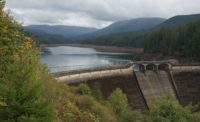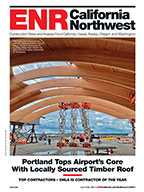
In December, the Portland Water Bureau granted final approval to an estimated $27.5 million-$29.5 million project that involves modifications to a water intake tower in the Bull Run Reservoir, the Oregon city’s primary supply. The project is designed to regulate water flow and maintain cooler water temperatures in the lower Bull Run River. The 150-ft tower, one of two, collects water that is either conveyed to the city’s water distribution system or released into the river. However, in its current capacity, the tower is limited to drawing water only from the bottom of the reservoir.
The improvements, designed by engineering consultant Black & Veatch, are needed to comply with Endangered Species Act and Clean Water Act requirements and include the installation of a 15-story, 385-ton steel wet well at the front of the existing tower. The structure will contain slide gates at multiple levels, enabling water to be extracted from three distinct elevations in the reservoir.
“We needed a way to save colder bottom water and control what we release downstream,” says Steve Kucas, senior environmental program manager with the Portland Water Bureau. “By being able to judicially pull water from three different levels, we can bank colder water for use later in the season when it is needed in the Bull Run River. Otherwise, by late summer, the water being sent downstream is too warm for fish habitat.”
Construction management and general contracting services for the project will be provided by Portland-based contractor Advanced American Construction (AAC) and will include crews of divers working at depths reaching 110 ft.
“Due to the depth of the dives, safety will be a paramount concern,” says Sam Barchus, project manager with AAC. “The installation will be complicated because of the limited amount of time that divers can stay at the bottom levels, where the majority of the work will occur.”
Accessed by smaller country roads and bridges, the isolated location of the reservoir poses another challenge. “Equipment such as barges and heavy cranes will need to be disassembled into small enough pieces to make it through the road network,” says Mike Stuhr, the Portland Water Bureau's chief engineer.
The structure itself will be delivered to the project site in large, trapezoidal segments, each with precisely fitted flanged connections, says Tim Collins, senior engineer with the Portland Water Bureau. “The pieces will be put together either on shore or in the water prior to being installed.”
Because the project is located in the city of Portland’s water source, a number of strict environmental controls will be implemented. For example, a large silt curtain will surround the north tower at all times, Stuhr says. “Equipment also will be thoroughly cleaned prior to entering the watershed in order to prevent the introduction of invasive species,” he adds.
The schedule calls for the project to be completed by the end of 2013.



Post a comment to this article
Report Abusive Comment